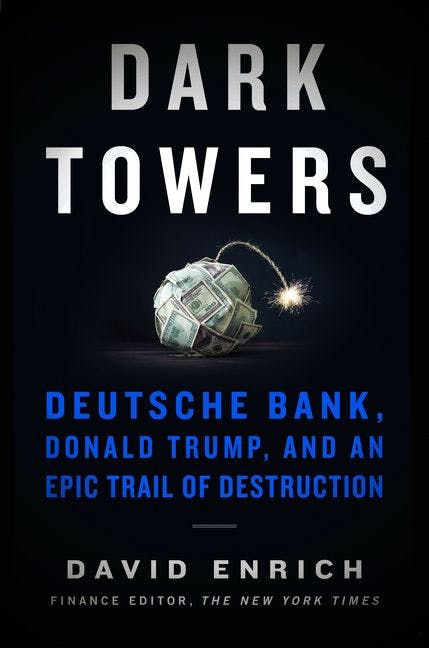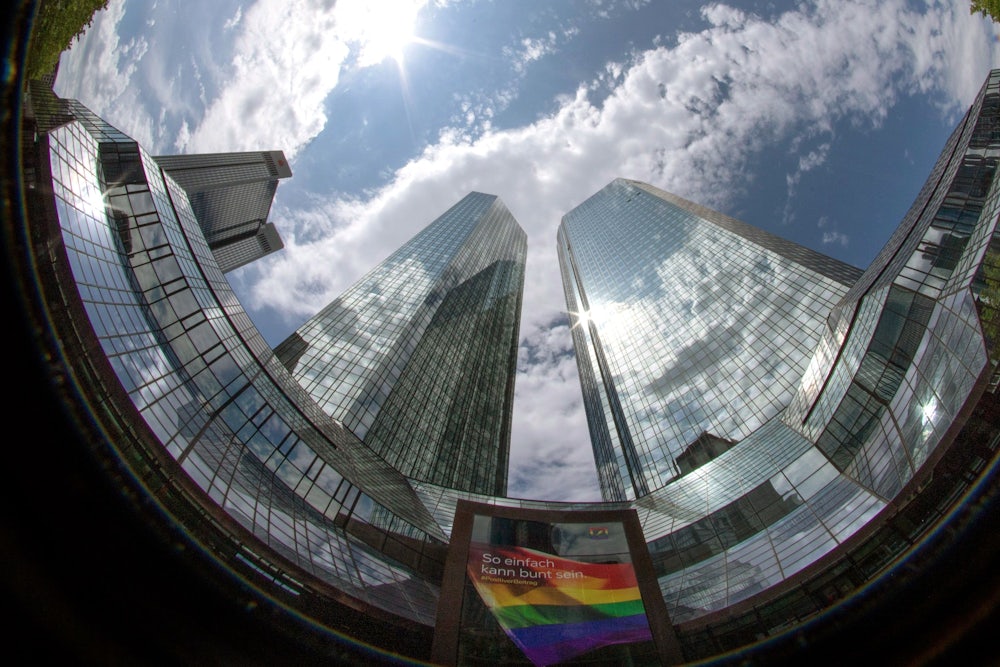In 1999, the German colossus Deutsche Bank was poised to acquire Bankers Trust. This purchase would give Deutsche a foothold in the United States and dramatically expand its investment banking business. The price was $10 billion, the largest foreign takeover of a U.S. bank in history. It would make Deutsche one of the largest financial institutions in the world. But there was a problem.

That February, New York City Comptroller Alan G. Hevesi announced he would try to block the merger until Deutsche Bank properly resolved claims by Holocaust survivors that the bank was complicit in Nazi war crimes. During the Nazi rule of Germany, the bank had, among other things, facilitated the transnational sale of gold stolen from Jews, which infused the Nazi war machine with cash. For decades, the bank’s official position had been to play down or deny its involvement. But the Bankers Trust merger was too important and too high profile.
And so it was that Deutsche Bank’s chairman, Rolf-Ernst Breuer, stated, “We deeply regret the misery and injustice suffered and ... we acknowledge the bank’s ethical and moral responsibility.” The world-historical irony was that—just as Deutsche Bank was admitting to having once been a sophisticated criminal organization—the merger would bring a whole new epoch of wrongdoing, a tidal wave of malfeasance so tall that it would not only drastically diminish the century-old bank but, once again, upend the geopolitical order. This story is the subject of David Enrich’s sharp new book, Dark Towers: Deutsche Bank, Donald Trump, and an Epic Tale of Destruction.
Enrich is the finance editor for the New York Times, a journalist who specializes in globe-spanning reportage backed up by deep access to an array of vivid characters. His last book, The Spider Network, was a meticulously reported story of a possibly autistic man at the center of a haphazard global conspiracy to manipulate the Libor rate. In Dark Towers, he doesn’t focus on a single character but instead takes on the more complicated task of profiling an entire organization, which he refers to as a “criminal enterprise.” He presents a portrait of a bank that, over its history—in desperate, reckless attempts to install itself as a global player—repeatedly turned to fraud, money laundering, and other crimes.
Enrich launches the book with the saga of Henry Villard, an erstwhile railroad tycoon in the U.S., whom Deutsche bankrolled in the 1880s. It was a period of rapid globalization, and European banks like Deutsche wanted a piece of the growing global market for railroad securities. This hunger made it easy for Villard to sell himself as a financial wizard when he was not. His first company, Northern Pacific, quickly became overextended and then collapsed, almost dragging Deutsche down with it. Villard, grounded for a moment, simply dusted himself off and asked to borrow more money. Inexplicably, Deutsche complied, only to get burned again when the railroad collapsed. It was reckless lending.
Far more disgraceful entanglements, however, would follow. When the Nazis first took power in Germany in the 1930s, Deutsche Bank financed the regime’s growth. But it didn’t stop at lending. “Deutsche soon started pressuring its clients to remove Jews from their boards of directors,” Enrich writes. Over 1,600 pounds of gold (“some of it extracted from Jews’ teeth,” Enrich adds) was melted down and sold internationally by Deutsche to fund the war effort. Bank officials reviewed plans for, and funded the construction of, Auschwitz.
At the conclusion of the war, the Allies broke Deutsche up into a score of separate banks. But too quickly the banks reorganized under the imprimatur of Deutsche Bank, and the chairman of the bank during Nazi rule, Hermann Abs, was reinstalled. Deutsche was unchastened. This reconstituted Deutsche Bank needed to play catch-up if it ever wanted to compete with British and U.S. banks. Luckily, it stepped into the financial vacuum of postwar Europe and became what Enrich calls “Europe’s only pancontinental lender.” It bought banks in Spain, Portugal, Italy, and the Netherlands and ramped up lending to the Soviet Union, to which it had been lending since the 1950s.
Deutsche Bank’s ambitions soon became global. In 1989, Alfred Herrhausen, a new leader of the bank, imperially declared that “as the world becomes our marketplace, we must be present in the world.” To that end, Deutsche bought the British investment bank Morgan Grenfell. Prior to this, Deutsche had been on the sidelines of an increasingly lucrative game: the sale of derivatives and other investment products. Deutsche followed up with another calculated move, hiring Edson Mitchell, a derivatives enthusiast, away from Merrill Lynch in the mid-1990s and thereby initiating, according to Enrich, one of the “greatest migrations in Wall Street history.” Deutsche more than doubled its investment banking staff in 18 months, practically overnight. Then came the acquisition of Bankers Trust, a bank that specialized in derivatives. The year before the merger, Deutsche made 29 percent of profits from investment banking; the year after, 85 percent.
Banking at the turn of the century grew hot. Derivatives and other products once meant to diffuse risk had proven themselves profitable. A new leader of the bank, Josef Ackermann, in 2003 said that in two years he wanted the bank to achieve a return on equity of 25 percent. The return the previous year had been 4 percent. To reach this benchmark, the bank now focused monomaniacally on selling investment products that just happened to be not only profitable but complicated and versatile enough to be used in a wide array of fraudulent activities.
In hindsight, it seems obvious that demanding a 25 percent return on equity would have caused an omnidirectional, ruptured-sewer-main spray of crime. Deutsche Bank was especially vulnerable because it had a long history of weaseling into crowded markets by lending where other banks wouldn’t. In the 1990s, to drum up money for Deutsche Bank’s commercial real estate unit, former Justice Anthony Kennedy’s son Justin arranged financing for Donald Trump, a man who had burned so many banks that institutions such as Citigroup and JPMorgan Chase wouldn’t lend him money. Two separate divisions of Deutsche had “sworn to never do business” with him again. After Ackermann’s declaration, it only got worse. Enrich shows how, by 2006, the bank had arranged for almost $11 billion to be sent to regimes sanctioned by the U.S. government, including Burma, Libya, Iran, Syria, and Sudan. One employee of Deutsche Bank wrote to another:
Please note that while DB is prepared to do business with Syria, we obviously have sizable business interests in the U.S., too, which DB wants to protect. So any Syrian transactions should be treated STRICTLY confidential …
It was all so obviously illegal.
Deutsche Bank also had a long-standing relationship with Russia, which only accelerated in the 2000s, as corruption deepened in the country. Oligarchs began moving money to Latvian banks that were affiliated with Deutsche, which then transferred the money to coveted U.S. accounts managed by shell companies (where it was then scattered to the four winds of the luxury real estate market). The Federal Reserve found out but only issued a slap on the wrist. Then, from 2011 to 2015, Deutsche Bank employees in Russia engineered a similar procedure called “mirror trades.” Russian clients bought stock with rubles and then sold the stock back to Deutsche bankers for the exact same amount in dollars, overseas. It was a scam of breathtaking simplicity, and also a breathtaking extent. Mirror trades liberated over $10 billion from Russia.
In Dark Towers, the scope and diversity of crimes committed by Deutsche in the last 20-odd years is hard to process: It manipulated the Libor rate, bribed Russian state officials, engaged in years of venal mortgage lending, tricked clients into buying faulty products, moved money for corrupt foreigners, helped hedge funds evade taxes, circumvented sanctions, and manipulated currency markets. It lent not only to Trump when no one else would, but to Jeffrey Epstein. It creates a fatigue that can drive the reader to lazy conclusions, and when Enrich writes that, “Deutsche might have been the industry’s worst offender, but it was hardly the only criminal entity. Just about every scandal that engulfed the bank during the past two decades also swept over at least one or two other rivals,” it’s easy to conclude that this is just the way things are.
But is it? While Enrich does a good job of revealing Deutsche Bank for what it is, his conclusions don’t make the important task of figuring out why it happened any easier. One possibility to infer from the book is that Deutsche was forever playing catch-up to the British and U.S. banks that have for the last 200 years dominated the globe. Deutsche perpetually tried to squeeze into markets with razor-thin margins and found the only way to profit was to act illegally or unethically. This would suggest it was historical circumstances that led Deutsche down the wrong path. But Enrich also mentions that “a German judge would later find that the fraud was enabled by the ‘risk-affirming climate’ that dominated Deutsche.” So should we conclude that criminality was somehow baked in to Deutsche’s company culture? Or maybe it is similarly encoded in the global banking system itself?
And what about the actions of individuals? As he did in The Spider Network, Enrich presents a tragic-hero-as-fall-guy, this time in the character of William Broeksmit, a Deutsche Bank derivatives expert and executive who killed himself in 2014. Enrich implies that Broeksmit was the guilty conscience of Deutsche: He often suggested that they should do the right thing. And yet he was still targeted by authorities, which was more than he could take. This narrative poses a critical question: If the main character is a fall guy—and thus, by implication, a victim of miscarried justice—where does the “epic trail of destruction” emanate from? Historical circumstances? Company culture? A few bad eggs?
The important point the book makes is that banking is the locus of enormous power with vast geopolitical consequences. We see this most prominently in the case of economic sanctions, which nowadays are a deadly form of warfare. Banks that enforce these sanctions are, unavoidably, political actors. The questions about how to constrain their actions are global, political questions. Deutsche Bank’s willingness to lend to dictators was driven by the same recklessness that drove it to shoot for a 25 percent return on equity. We could have looked at that absurd metric and seen a society barreling downhill toward a powder keg, but instead, it was reported without event. Should banks be allowed to be so reckless in the first place? We’ve done little to constrain this type of behavior. Today, Deutsche is unraveling its investment banking activities. It, once again, shrinks back into the hole it rose out of. But will it rise again?
